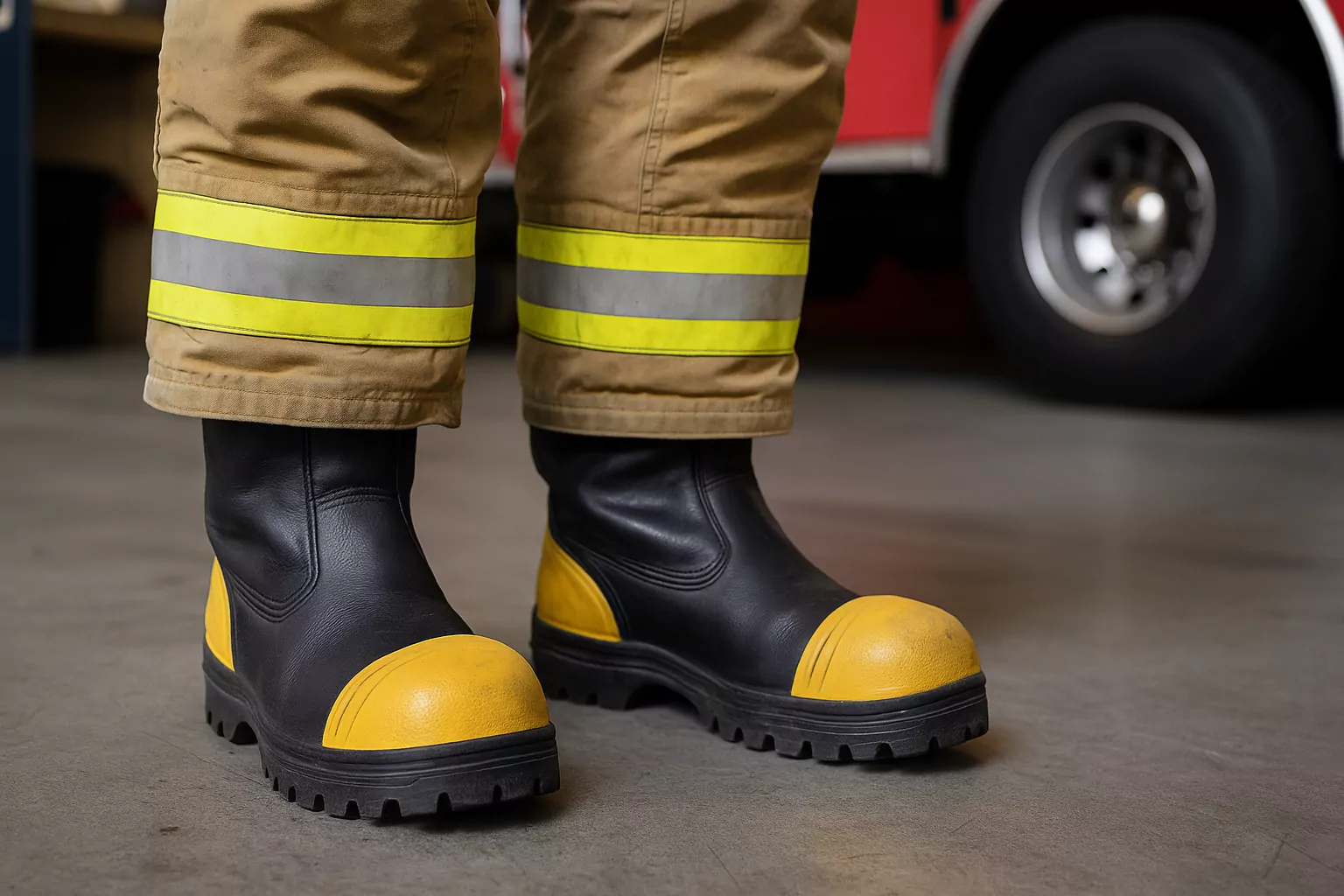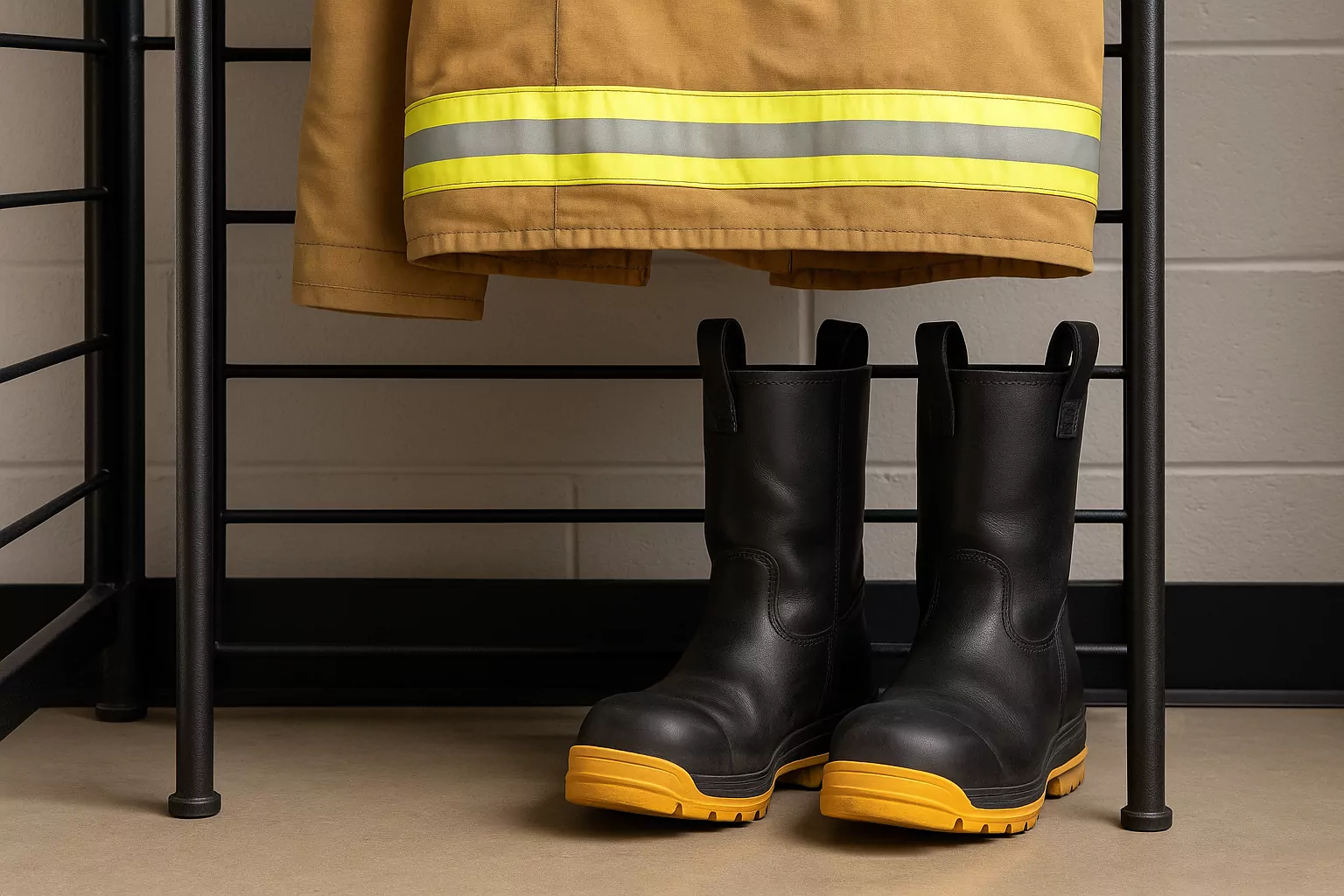Unlike station boots, structural bunker boots are worn directly into structural firefighting, making them among the most common structural firefighting boots used in the U.S. fire service. Because they face direct exposure to flame, high radiant heat, sharp objects, and hazardous liquids, each firefighting boot must meet or exceed NFPA 1970 and ASTM F2413 standards and is typically SEI-listed. Most feature a full-length 14–15-inch shaft that interfaces with bunker pants to seal out water and embers, along with fire-resistant rubber insulated or leather structural constructions, moisture barriers, puncture resistant plates, ladder shanks, and heat- and slip-resistant lug soles. A damaged fire boot or a foot injury during an incident can have the same operational impact as losing a crew member—reducing readiness and increasing operational risk—so recognized manufacturers engineer bunker boots to prevent those failures.
What Are Bunker Boots?

Bunker boots are structural firefighting boots purpose-built for interior attack, rescue, and other IDLH operations. Each firefighting boot must meet or exceed NFPA 1970 and ASTM F2413 requirements and is typically SEI-listed, providing verified protection against heat, impact, penetration, slips, and electrical hazards.
Most structural bunker boots use a full-length shaft around 14 inches to interface cleanly with bunker pants and seal out heat, water, and embers. Uppers are commonly rubber insulated (rubber boots) or leather structural, chosen for fire-resistant and chemical-resistant performance. Inside, a moisture barrier helps block liquids such as diesel fuel, hydraulic fluid, and battery acid. Underfoot, puncture resistant plates address hazards from sharp objects and debris, while ladder shanks provide rung stability. Outsoles are heat-rated boot with lug sole designs engineered for traction on wet, oily, or debris-covered surfaces and to retain structural integrity under sustained radiant heat exposure (≈500°F / 260°C for several minutes under typical NFPA heat-exposure protocols). Toe protects are provided by steel toe or composite caps. Many premium models also optimize fit and ankle support to maintain mobility without sacrificing protection.
Bunker boots are frontline fire boots for structural firefighting—environments with high radiant heat, collapse hazards, falling debris, and hazardous liquids. They are not intended to replace wildland or station boots, where endurance hiking or all-day duty comfort drive different design priorities.
Globe Supreme 14″ Structural Bunker Boot: leather structural upper, moisture barrier, ladder shank, heat-rated boot with lug sole, steel toe, and third-party certification—engineered to meet or exceed NFPA/ASTM criteria while maintaining fit and mobility.
Why They’re Called “Bunker Boots”

Early fire stations kept boots pre-positioned with turnout pants in the lower compartment—the “bunker” shelf—of a locker or gear rack. The pant cuffs were folded over the shafts so a firefighter could step into both pieces in one motion as the alarm hit, cutting turnout time and keeping the set ready on the apparatus bay floor.
As research and field experience highlighted contamination risks—carcinogenic soot and PAHs, diesel particulates, heavy metals, and PFAS residues—departments updated procedures in line with NFPA 1851 selection, care, and maintenance guidance. Boots are now commonly stored separate from pants in ventilated racks or boot-only dryers; bagged for transport; and cleaned/decontaminated after soiling rather than left nested inside turnout gear. Many agencies also prohibit storing contaminated boots in living areas or cab interiors to reduce cross-contamination.
Despite the storage changes, the name “bunker boots” stuck and remains the dominant U.S. term for structural firefighting boots. You’ll also see “turnout boots” or “structural bunker boots.” In some locales they’re informally called “combat boots,” but that label can be confused with military footwear, so technical documents typically avoid it.
Materials and Construction of Bunker Boots

Upper constructions — rubber insulated & leather structural.
Structural firefighting boots are built in two dominant upper systems. Rubber insulated models use vulcanized natural/synthetic rubber shells with reinforcement scrims; they’re inherently waterproof, fuel/chemical tolerant, cold-flexible, and typically paired with a thermal liner for insulation and comfort. Leather structural models use full-grain, flame-resistant leather with hydrophobic finishes; they offer cut resistance, better MVTR-driven breathability, and ergonomic ankle flex for mobility. Both constructions are certified as elements of the structural ensemble under NFPA 1970.
Barrier & underfoot protection.
Boots incorporate a PTFE/PU moisture barrier to block liquid penetration (diesel, hydraulic fluid, battery acid) while allowing moisture vapor transfer. Underfoot, puncture resistant stainless or composite plates guard against sharp objects per ASTM penetration methods, alongside electrical-hazard (EH) provisions. Toe protects are delivered by steel toe or composite caps that meet or exceed ASTM F2413 impact/compression ratings (I/75, C/75).
Outsoles & heat/slip performance.
Heat-rated boot with lug sole designs are compounded from nitrile/high-temp rubbers to maintain traction on wet/oily/debris surfaces and to tolerate sustained radiant/convective heat exposures required in NFPA footwear testing. Many premium models use Vibram Fire & Ice compounds that maintain flexibility and traction from roughly −20 °C to +250 °C and satisfy NFPA flame-resistance needs—useful for cold-weather incidents with hot surfaces.
Structural supports & ladders.
Ladder shanks or full-length boards add midfoot rigidity and rung stability without over-stiffening the forefoot, preserving climb control under load; these elements are conditioned and evaluated alongside other components during NFPA heat/conditioning sequences.
Manufacturing processes & QC.
Rubber boots are built by lay-up and vulcanization (press cure) for wall-thickness uniformity and shell bonding; leather structural boots are lasted, stitched (cemented, welted, or stitch-down), and sealed at stress points. Production lots undergo dimensional checks plus destructive tests (e.g., outsole adhesion, tear/tensile, puncture) before certification release; departments should verify SEI-listed compliance and the applicable NFPA 1970 edition for procurement.
What NFPA/ASTM tests mean in practice.
For footwear elements, NFPA 1970 specifies heat/thermal conditioning (e.g., convective and radiant heat conditioning prior to performance tests), flame exposure, slip resistance on prescribed surfaces, liquid integrity, and other hazards; these regimes ensure boots meet or exceed the ensemble’s thermal and mechanical thresholds in structural firefighting boots. ASTM F2413 covers the toe impact/compression and related classifications used across models.
Bunker Boots vs. Station Boots & Wildland Fire Boots
Bunker Boots – Designed for structural firefighting, with tall shafts (≈14″), rubber insulated or leather structural construction, boot with lug sole, steel toe, and full thermal, puncture, and chemical protection to meet or exceed NFPA 1970. Built to handle interior attack, flashover-level heat, and debris-heavy environments.
Station Boots – Worn for daily station duties and non-emergency tasks. Shorter height (6–8″), lighter weight, often leather with comfort-oriented soles. Not rated for structural firefighting heat or chemical hazards; typically meets basic ASTM impact/slip standards only.
Wildland Fire Boots – Purpose-built for prolonged outdoor wildfire operations. Leather uppers (often 8–10″), Vibram-style heat-resistant soles, no waterproof liner (to keep weight low and avoid steam burns). Meets NFPA 1977 for wildland PPE; prioritizes endurance, hiking comfort, and protection from embers and terrain hazards.
In short: Bunker Boots are heavy-duty, heat-and-impact armor for burning structures; Station Boots are comfort-focused work footwear; Wildland Fire Boots are endurance gear for long, hot, outdoor firefights.
Bunker boots are essential structural firefighting boots engineered to protect against extreme heat, hazardous materials, and mechanical threats, combining specialized materials, rigorous construction, and compliance with NFPA standards.
At Poseidon, we provide a full range of bunker boot solutions—rubber insulated, leather structural, and advanced hybrid models—tailored to meet your operational needs. Contact our experts today to upgrade your fireground protection and performance.
